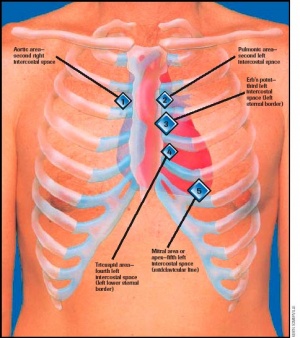Difference Between Discontinuous and Continuous Lung Sounds
Introduction [edit | edit source]

The auscultation of the respiratory system is a noninvasive, safe, easy-to-perform, and one of the oldest diagnostic techniques used by physiotherapists and physicians to diagnose various pulmonary diseases and assess the quality and changes in a patients lungs. It is performed using a stethoscope.
Breath sound have three characters; frequency, intensity, and quality; which helps us to differentiate two similar sounds.[1]
Auscultation of the lung is an important part of respiratory examination and is helps in diagnosing various respiratory disorders. Auscultation assesses airflow through the trachea-bronchial tree. It is important to distinguish normal respiratory sounds from abnormal ones for example eg crackles, wheezes, and pleural rub in order to make correct diagnosis[2] and chart improvement or otherwise.
To hear the sounds described see Auscultation
Lung sounds [edit | edit source]

Classified into the following three categories:
- Breath sounds
- Voice sounds
- Adventitious sounds
Breath sounds [edit | edit source]
Normal Breath Sounds (Vesicular Sounds) [edit | edit source]
The intensity and quality of breath sounds depends on the site of Auscultation. Sounds produced in the large airways have some of their energy content attenuated and filtered during conduction through pulmonary tissue, so that only a narrow range of frequencies (<500 Hz) is heard over the chest wall in normal patients. Thus in health, over most of the chest, the breath sounds are low-pitched and have a relatively quiet expiratory phase.[1] The inspiratory component originates in the lobar and segmental airways, whereas the expiratory component arises from more central airways.[3]
They are soft, low pitched, and rustling in quality. The inspiratory phase lasts longer than the expiratory phase with a ration (I:E) of 2:1.
Bronchial Breathing [edit | edit source]
Breath sounds heard close to large air passages have a louder and longer expiratory phase and their energy components extend over a broad frequency range (<200 – 4000 Hz). In health, such sounds are heard only over the large air passages e.g. the trachea. In the presence of consolidation or cavitation there is less filtration and attenuation of the sounds produced in the large airways, so that the sounds heard over the chest wall are similar to those heard over large air passages such as the trachea. Amphoric and cavernous breathing are varieties of bronchial breathing, which are heard over cavities communicating with a bronchus (selective amplification of low frequency sounds).[1]
Soft Breath Sounds [edit | edit source]
Fluid or air in the pleural space deflects sound waves away from the chest wall back into the lung and therefore breath sounds are reduced in intensity.
Diminished or Absent Breath Sounds [edit | edit source]
An important feature of auscultation is recording the intensity of the breath sound. Intensity can be reduced due to several factors: Weak sound generation and/or impaired transmission.[4] Various causes are shallow breathing, airway obstruction, bulla, hyperinflation, pneumothorax, pleural effusion or thickening, and obesity.
Voice Sounds [edit | edit source]
Voice sounds produced in the larynx are also filtered and attenuated during their conduction through lung tissue, and because of this, speech is incomprehensible when we listen to it over the chest wall with a stethoscope. In the presence of consolidation or cavitation of the lung, less filtration and attenuation occurs and therefore voice sounds can be heard more clearly over the chest wall.
The term used to describe the voice sounds heard over consolidated lung is bronchophony (also called vocal resonance). It can be determined through the stethoscope when the patient says "99", usually just audible but becoming louder when the lung is consolidated. Pectoriloquy is abnormal transmission of the patient's voice sounds through the chest wall so that they can be clearly heard through the stethoscope. The term used to describe whispered speech heard over consolidated lung (as in pneumonia), is whispering pectoriloquy. Bronchophony and whispering pectriloquy have the same implications as bronchial breathing i.e. consolidation or cavitation of the lung with improved transmission of sound. Aegophony is a form of bronchophony in which the spoken syllables have a peculiar nasal or bleating quality, and these arise from the transmission of sound through compressed lung just above a pleural effusion.
Adventitious Sounds [edit | edit source]

Crackles [edit | edit source]
These may be either coarse or fine. They are discontinuous, interrupted explosive sounds. Coarse crackles or crepitations are associated with bronchiectasis or resolving pneumonia, whereas fine crackles can be heard with either pulmonary oedema or interstitial fibrosis.
Wheezes [edit | edit source]
These may be high pitched or low pitched and are continuous sounds associated with airway narrowing due to a variety of causes, including bronchoconstriction and excessive secretions. Loud wheezes are heard with the naked ear, soft wheezes only with the stethoscope.
- Monophonic wheezing consists of a single musical note starting and ending at different times. A local pathology-like bronchial obstruction by tumor, bronchostenosis by inflammation, mucus accumulation, or a foreign body can produce this sound. In case of rigid obstruction, the wheeze is audible throughout the respiratory cycle, and when the obstruction is flexible, wheeze may be inspiratory or expiratory.
- Polyphonic wheezing consists of multiple musical notes starting and ending at the same time and is typically produced by the dynamic compression of the large, more central airways. Polyphonic wheeze is confined to the expiratory phase only.[1]
Stridor [edit | edit source]
Stridor is a loud, high-pitched, musical sound produced by upper respiratory tract obstruction.[5] It is different from wheezing by the following reasons. It is louder over the neck than chest wall. Secondly; stridor is mainly inspiratory.[1]
Mediastinal Crunch [edit | edit source]
A hoarse crackling sound synchronous with systole, heard over the pericardium in the presence of mediastinal emphysema.
Pleural Rub [edit | edit source]
A discontinuous grating sound or creak in phase with breathing that occurs in the presence of pleural inflammation. Friction rubs are heard better when the stethoscope is applied firmly to the chest wall. Pleural rubs must be distinguished from similar sounds produced by movement of the scapula, ribs and thoracic musculature under the stethoscope. The latter disappear on repositioning of the stethoscope, changing pressure of application to the chest wall or by repositioning of the patient.
Pleuro-Pericardial Rub [edit | edit source]
A sound with features of both pleural and pericardial rub.
Unclassified Noises [edit | edit source]
These are adventitious sounds not easily characterised by the above term. These include rattles, squeaks, gurgling, etc.
Conclusions [edit | edit source]
To be able to differentiate these sounds practice with as many people as possible. Listen to normal healthy lungs first and it will be easier to then listen for the abnormal. Bedside teaching should be strengthened in order to avoid erosion in this age old procedure in the era of technological explosion.[2]
References [edit | edit source]
- ↑ 1.0 1.1 1.2 1.3 1.4 Sarkar M, Madabhavi I, Niranjan N, Dogra M. Auscultation of the respiratory system. Annals of thoracic medicine. 2015 Jul;10(3):158.
- ↑ 2.0 2.1 Sarkar M, Madabhavi I, Niranjan N, Dogra M. Auscultation of the respiratory system. Annals of thoracic medicine. 2015 Jul;10(3):158. Available from: https://www.ncbi.nlm.nih.gov/pmc/articles/PMC4518345/ (last accessed 8.10.2019)
- ↑ Kraman SS. Determination of the site of production of respiratory sounds by subtraction phonopneumography. Am Rev Respir Dis. 1980;122:303–9.
- ↑ Bohadana AB, Peslin R, Uffholtz H. Breath sounds in the clinical assessment of airflow obstruction. Thorax. 1978;33:345–51.
- ↑ Bohadana A, Izbicki G, Kraman SS. Fundamentals of lung auscultation. N Engl J Med. 2014;370:744–51.
Source: https://www.physio-pedia.com/Lung_Sounds
0 Response to "Difference Between Discontinuous and Continuous Lung Sounds"
Post a Comment